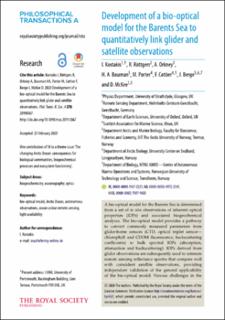| dc.contributor.author | Kostakis, I. | |
| dc.contributor.author | Röttgers, R. | |
| dc.contributor.author | Orkney, A. | |
| dc.contributor.author | Bouman, H.A. | |
| dc.contributor.author | Porter, M. | |
| dc.contributor.author | Cottier, Finlo Robert | |
| dc.contributor.author | Berge, Jørgen | |
| dc.contributor.author | Mckee, David | |
| dc.date.accessioned | 2021-02-19T10:28:16Z | |
| dc.date.available | 2021-02-19T10:28:16Z | |
| dc.date.created | 2021-02-01T13:40:24Z | |
| dc.date.issued | 2020 | |
| dc.identifier.citation | Philosophical Transactions of the Royal Society A: Mathematical, Physical and Engineering Sciences. 2020, 378 (2181), . | en_US |
| dc.identifier.issn | 1364-503X | |
| dc.identifier.uri | https://hdl.handle.net/11250/2729163 | |
| dc.description.abstract | A bio-optical model for the Barents Sea is determined from a set of in situ observations of inherent optical properties (IOPs) and associated biogeochemical analyses. The bio-optical model provides a pathway to convert commonly measured parameters from glider-borne sensors (CTD, optical triplet sensor—chlorophyll and CDOM fluorescence, backscattering coefficients) to bulk spectral IOPs (absorption, attenuation and backscattering). IOPs derived from glider observations are subsequently used to estimate remote sensing reflectance spectra that compare well with coincident satellite observations, providing independent validation of the general applicability of the bio-optical model. Various challenges in the generation of a robust bio-optical model involving dealing with partial and limited quantity datasets and the interpretation of data from the optical triplet sensor are discussed. Establishing this quantitative link between glider-borne and satellite-borne data sources is an important step in integrating these data streams and has wide applicability for current and future integrated autonomous observation systems. | en_US |
| dc.language.iso | eng | en_US |
| dc.publisher | The Royal Society | en_US |
| dc.rights | Navngivelse 4.0 Internasjonal | * |
| dc.rights.uri | http://creativecommons.org/licenses/by/4.0/deed.no | * |
| dc.title | Development of a bio-optical model for the Barents Sea to quantitatively link glider and satellite observations: A bio-optical model for the Barents Sea | en_US |
| dc.type | Peer reviewed | en_US |
| dc.type | Journal article | en_US |
| dc.description.version | publishedVersion | en_US |
| dc.source.pagenumber | 22 | en_US |
| dc.source.volume | 378 | en_US |
| dc.source.journal | Philosophical Transactions of the Royal Society A: Mathematical, Physical and Engineering Sciences | en_US |
| dc.source.issue | 2181 | en_US |
| dc.identifier.doi | 10.1098/rsta.2019.0367 | |
| dc.identifier.cristin | 1885054 | |
| dc.description.localcode | © 2020 The Authors. Published by the Royal Society under the terms of the Creative Commons Attribution License http://creativecommons.org/licenses/by/4.0/, which permits unrestricted use, provided the original author and source are credited. | en_US |
| cristin.ispublished | true | |
| cristin.fulltext | original | |
| cristin.qualitycode | 1 | |

